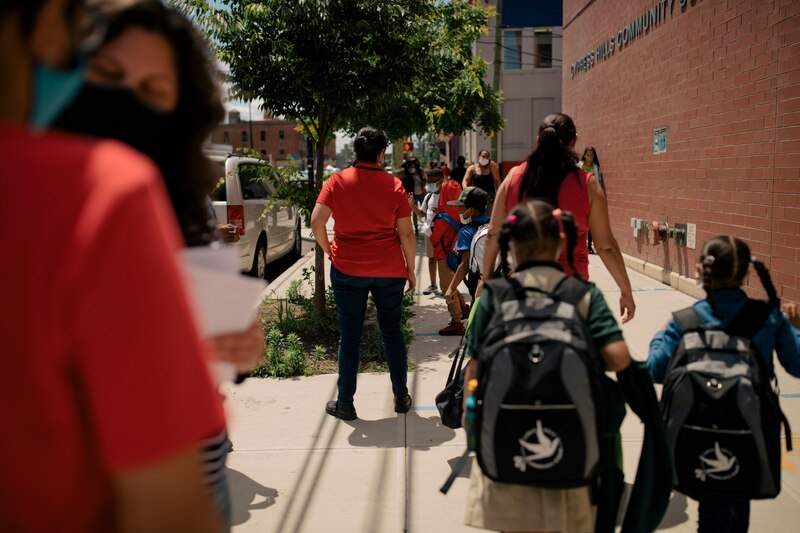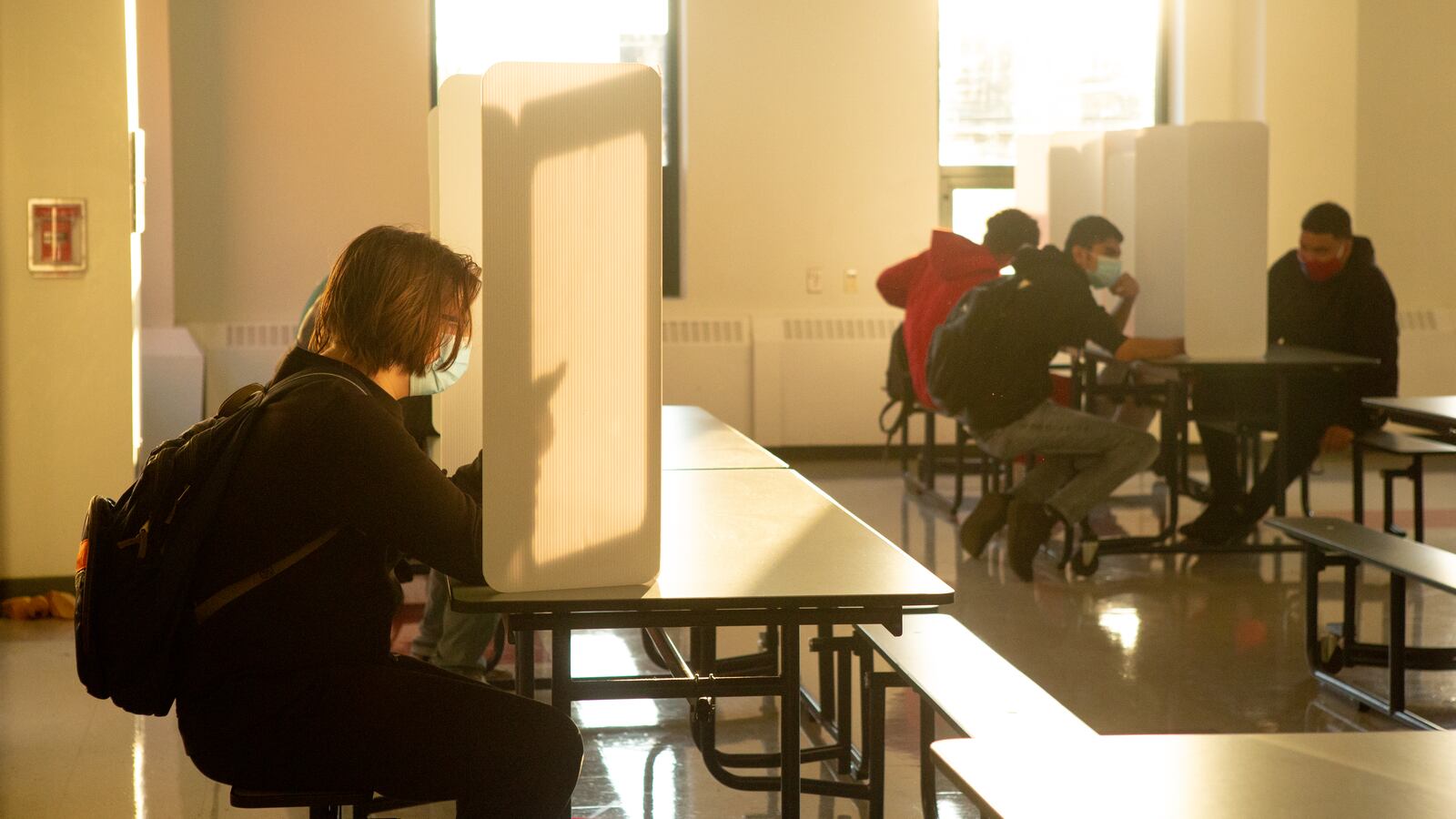Barry Gardner, the chief financial officer of an Indiana school district, has been watching a national narrative forming about schools and COVID relief dollars with some puzzlement.
A number of news and opinion pieces have suggested that federal money for schools is being poorly accounted for at best, and wasted at worst. Districts have also been criticized for not spending those dollars quickly enough.
“There’s a weird memory-holing of the fact [that] last spring Congress distributed $123 billion dollars to K-12 schools for Covid preparedness,” Chris Hayes, the progressive MSNBC host, recently wrote in a viral tweet. “What was that used for?”
“We have to have some level of accountability,” Dean of the Brown University School of Public Health Ashish Jha said on a New York Times podcast in January. “Why can’t we assume and expect that our district leaders or school leaders will take the billions of dollars that Congress has given them for something and do something with that?”
That’s where the disconnect for Gardner opens up. He can account for every dollar his district, Wayne Township, plans to spend. He can point to a public plan for those dollars. And he can explain to any parent who asks what that money is buying now and what it will buy over the next several years.
“The national narrative I tend to see has been that schools aren’t up to the task,” he said. “I think that’s far from the truth.”
The reality? Both sides have a point.
Many districts, like Wayne Township, where Gardner works, have plans for how they will spend the money. The idea that schools aren’t spending it quickly partly reflects a monthslong lag in the data, not local officials dragging their feet. And the best evidence available suggests that schools are making seemingly reasonable purchases: buying masks, computers, and air filters, while adding summer school programs, tutoring, counselors, and teachers.
But district plans vary widely in quality, and there are more than 13,000 school districts across the country. Zoom out further, and, so far, information at the state and national levels is limited, incomplete, or nonexistent, making it difficult to closely monitor this unprecedented infusion of federal cash.
“People thought there was going to be a big answer,” said Marguerite Roza, director of the Edunomics Lab, a school finance group. “And there isn’t — there’s a lot of different spending and it varies from one district to the next.”
District COVID spending plans are findable, but not all are helpful
In 2020 and 2021, Congress passed three COVID relief packages that added up to over $190 billion for public and private schools. The vast majority of that money has gone to school districts.
For the Metropolitan School District of Wayne Township — which covers the west side of Indianapolis, serving 16,000 students with 17 schools — the two most recent rounds of COVID relief brought in $53.5 million. Its plan for spending this money includes the following:
- $13.6 million to hire staff to create a fully virtual K-8 school
- $9.7 million for 42 new staff positions, including reading interventionists and teachers to support students learning English
- $8.7 million for HVAC upgrades
- $6.1 million for Chomebooks, hotspots, and other tech upgrades
- $4.9 million for personal protective equipment and custodial supplies
- $2.6 million for “student and employee wellness,” including a wellness coach
- $1 million to support extracurricular activities
- $783,000 for curriculum and other supplies
“Every dollar is budgeted and accounted for,” Gardner said.
Reasonable people could disagree with the particulars. Some might worry that the hiring spree is unsustainable (Gardner emphasized the new positions are only temporary) or wonder whether the money for extracurriculars is really responsive to the pandemic (Gardner said clubs and sports struggled because they couldn’t fundraise like usual last year).
The plan could also be more detailed. It doesn’t include a line item for each subcomponent, for instance, and the wellness spending is particularly vague. It’s also just a plan. Actual spending has largely aligned with this budget, Gardner said, though the district made some adjustments after struggling to hire for some roles.
Those plans do — or at least should — offer a meaningful guide to districts’ intentions. All districts are required to publicly detail how they will use the largest pot of federal money. Chalkbeat was able to quickly find plans for each of Indiana’s 10 largest districts. (Links are also posted on the U.S. Department of Education’s website.)
The plans, at least those of Indiana’s large districts, vary widely in their clarity and specificity, though.
Some are even more detailed than Wayne’s. Others don’t include dollar amounts for any item, while still others include only dollar amounts with no elaboration beyond a couple words. A few use a template that is difficult to read. And most lack clear details, required by the federal government, about how the district will address the particular needs of “those students disproportionately impacted by the COVID-19 pandemic.” (A spokesperson for the state said that districts had to provide “assurances” that they would indeed implement strategies to respond to the needs of those students.)
“Among districts, some provide more detail, others provide more financials, and some look more like a box-checking exercise,” said Roza, who has reviewed many district plans.
Finding information at the state or national level is a lot harder
So yes, plans for Wayne Township and other nearby districts are publicly available. In Indiana, a recently posted dashboard also shows how quickly each district, and the state as a whole, is spending its federal money.
Other states, including Georgia and Massachusetts, have similar trackers. But these dashboards, including Indiana’s, don’t say anything about what the money is actually being spent on. A few states, including Kansas and New Mexico, have offered some details on spending decisions.
Most, though, haven’t produced any statewide data — at least none that Chalkbeat could find after reviewing all 50 state education department websites. Spending for private schools appears even harder to track since they aren’t required to post public plans.
“States at some point are going to be asked to speak to: How was the money spent? And what was the outcome?” said Heather Boughton, director of education policy implementation at Results For America, where she works with state leaders to improve their data systems. “Although states do collect some of that information, they certainly don’t collect it at the level of detail that would be ideal for answering those kinds of questions.”
Federal data isn’t much better. The U.S. Department of Education has a “transparency portal” for tracking how much COVID relief money has been spent. But district leaders and school finance experts say its numbers are misleading.
Right now, the site reports that only 12% of the money allocated to Indiana districts has been spent, for example. With numbers like that, it’s understandable that some politicians think that school districts are sitting on money they don’t truly need.
But the federal figures reflect a long data lag. When a district pays a bill with federal money, it takes time for that to be reported to state agencies and then up to the federal government. And the data hasn’t been updated at all since September 2021.
In Indiana, for instance, the state now reports that 20% of the money has been used.
That still might not seem like a lot, but there is another wrinkle: when a school hires a new reading interventionist or starts a project to improve ventilation — both things Wayne Township has done — the money isn’t spent all at once. A new staff member is paid an annual salary over the course of months; an HVAC upgrade takes time to contract, design, and implement.
“By the time you get to the national level, you’ve got a lot of lag plus a lot of uncertainty in what we’re calling ‘spent,’” said Nat Malkus, a senior fellow at the American Enterprise Institute, a conservative think tank where he has analyzed COVID relief spending.

The portal also offers an annual report breaking down where that money has gone. But more than half of the spending through September 2020 was categorized as “other,” according to an analysis by ProPublica.
That gets at a key issue with trying to understand this spending. If a district pays teachers more to work extra hours to help struggling students, that might reasonably be called “teacher bonuses” or “after school programming” or “learning loss mitigation” or “tutoring” — or if officials are providing information to the feds, “other.” Without standardization nationwide, the result is chaotic.
“We’ve done a terrible job nationally investing in data and technology structures to accommodate this type of reporting in a normalized way,” said Jess Gartner, who runs the company Allovue, which sells school finance technology tools. “That is the failure — not that districts don’t care or don’t have a plan or aren’t tracking these dollars internally.”
Gartner points out that school spending data at the national level is usually reported on a multi-year lag.
Ian Rosenblum, who was until recently deputy assistant secretary at the U.S. Department of Education, said it’s clear the dollars have made a difference to schools.
“We’re seeing across the country the real impact of these funds on addressing things like HVAC systems that help support safe in-person instruction, on making sure there are enough teachers in the classroom, that there are more school counselors,” he said.
Rosenblum also pointed out that the administration recently adjusted reporting requirements to try to improve the data.
The new survey asks district officials to report spending in four broad categories including “operational continuity and other allowed uses” and “meeting students’ academic, social, emotional, and other needs.” Eventually districts will have to report more detailed spending under each of these categories — but that won’t begin until officials report on spending from 2023.
The best data we have shows schools are spending on COVID safety, staff, learning loss, and HVAC
We’re not totally in the dark about how the federal money is being budgeted, and it seems like most districts are taking an approach not unlike Wayne Township’s.
The private company Burbio has combed through over 2,700 district plans for spending the most recent pot of federal money, and then attempted to categorize them in standardized ways. Using that data, Georgetown-based think tank FutureEd found the most common items included summer learning, after-school programming, HVAC upgrades, more teachers and counselors, personal protective equipment, new technology and devices, professional development, and tutoring.
“The collective plans provide a reason to be optimistic,” FutureEd analysts Phyllis Jordan and Bella DiMarco concluded. Instances of obviously questionable spending, like upgrades to sports facilities, were quite rare, at least in public plans.
More difficult than tracking the spending plans: understanding how it affects students. “None of this gives us an answer on whether or not the investments are yielding benefits for kids,” said Roza.
Those answers will require careful research. Mark Schneider, director of the U.S. Department of Education research arm, says education spending will be included in an administration-wide effort to evaluate the American Rescue Plan — “but it’s too soon to know what that looks like.”
Politics may not wait. When the money was first approved, Democratic Rep. Bobby Scott urged districts to spend the money well and then make the case for more. Research prior to the pandemic generally showed that more money did improve outcomes for students. But the limited tracking and the lagging research may add to the perception that the dollars were wasted.
Christopher Candelaria, a professor at Vanderbilt University who has studied the impact of additional school funding, said simple answers may be hard to come by.
“Although spending plans reflect best intentions,” he said, “the quality of the programs may vary substantially.”


